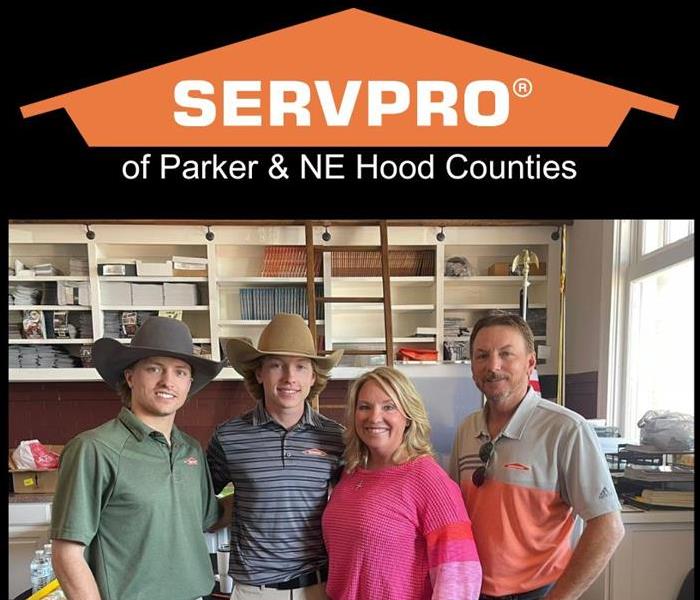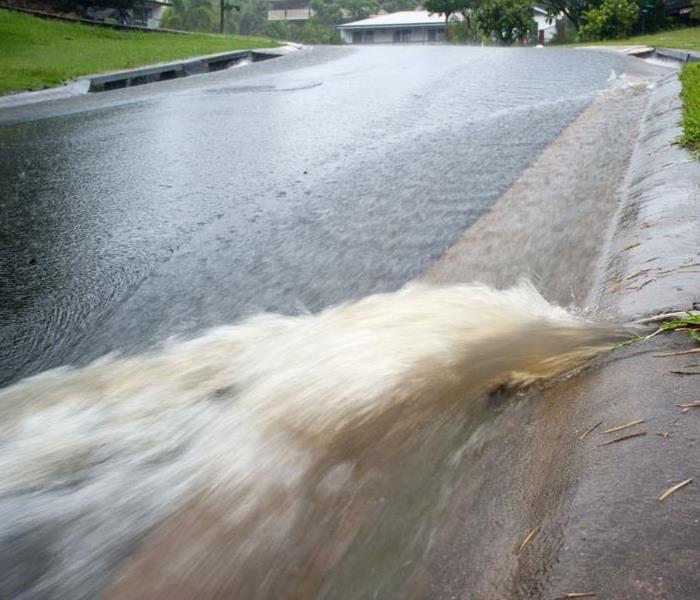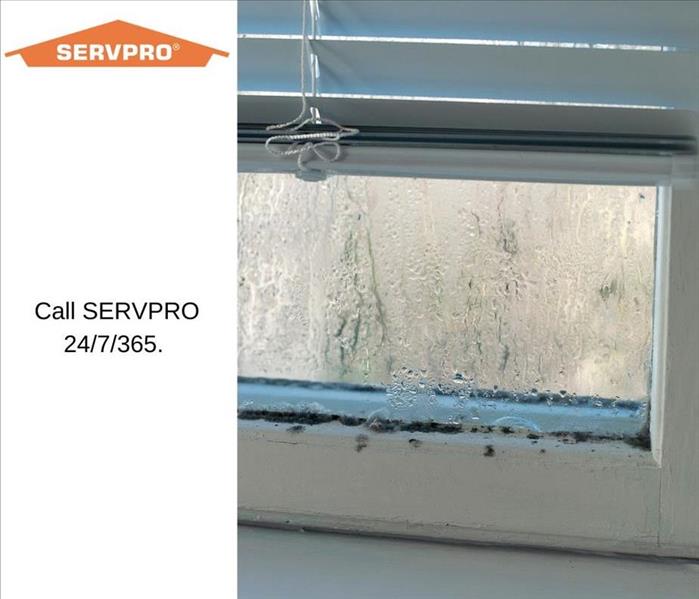Recent Posts
Water Moves In Strange Ways
12/9/2024 (Permalink)
In the water mitigation world, it is very important that we check every inch of wall and flooring after a flood. Whether it be a small sink overflow, and busted pipe, or a huge storm, finding all the moisture in the affected area is a must. Water will move in strange ways sometimes. Years of studies and experience shows that no matter how much we think we know, or how we may predict the water to move, we cannot truly be sure. If a SERVPRO® technician comes to your home to scope, they may start to look in places where water did not necessarily go. To prevent further damage and mold growth to begin, all moisture must be extracted. If you need any services from our SERVPRO professionals, do not hesitate to call!
Burn Baby Burn, or Don't!
12/9/2024 (Permalink)
Do you have a fire extinguisher in your home? Do you know what kind of fire that extinguisher is made for? Did you know that homeowners are recommended to have at least FOUR fire extinguishers in their home? Chances are, probably not. A common misconception is that one fire extinguisher is made to put out any fire, when in reality, there are actually four different classes of fire extinguishers and they are all made for different purposes.
The four classes of fire extinguishers are labeled "A, B, C, and D". Class "A" is most commonly the extinguisher found in households because it puts out ordinary combustibles such as paper and wood; this is also the most well known extinguisher. The other three classes will be described below:
- Class B: Class B extinguishers are for use on flammable liquids like grease, gasoline, and oil.
- Class C: Class C extinguishers are for use on electrical fires only
- Class D: Class D extinguishers are designed to put out flammable metals.
Some extinguishers are multipurpose, and can be suitable for two or more classes of fire. If this is the case, the extinguisher will be labeled as such (A-B, B-C, or A-B-C). Professionals recommend that every home and business owner have at least one fire extinguisher for each class. This will ensure preparedness in any burning situation.
When engaging a fire extinguisher, it is important to remember to P.A.S.S.
- Pull the pin on the fire extinguisher to break the seal.
- Aim the fire extinguisher low, at the base of the fire.
- Squeeze the handle of the extinguisher to release the extinguishing agent.
- Sweep the nozzle from side to side at the base of the fire until the fire is fully put out.
In case your home does experience the devastation of a fire, SERVPRO of Parker and Northeast Hood Counties can take over the cleaning and restoration process to relieve some of the stress on your shoulders! You can contact us anytime, 24/7, at 817-596-8714.
The Sewage Clean Up Processes
1/14/2024 (Permalink)
If your home is flooded with sewer water, the mitigation process is far different from a general water loss. Here are the eight basic steps that our team at SERVPRO of Parker and Northeast Hood Counties follow when it comes to the mitigation of sewage.
- Wear Personal Protective Equipment
Sewage water is considered a Category 3 water loss. Because of this, technicians must wear impervious coveralls, rubber boots, goggles, and a face mask with a respirator to protect themselves from contaminants.
- Contain the Area
To prevent bacteria and other germs from spreading to other areas of the home, the area must be contained before the clean-up process begins.
- Pump Excess Water Out
Standing water is extracted through an industrial pump. It flows into a tank where it remains until it can be discarded safely after water cleanup.
- Remove Affected Items and Materials
All items in the area must be removed. If they cannot be cleaned, they are discarded. Walls, ceilings, and flooring must also be removed if they are touched by contaminated water along with toiletries and food items.
- Dry All Surfaces
All surfaces must be dried to avoid secondary damage. Technicians may use air movers or open windows to circulate fresh air from outside.
- Clean All Surfaces
Because sewer water contaminates everything it touches, all surfaces must be disinfected. Experts use powerful cleansers and tests to ensure that bacteria is gone.
- Restore Materials
After everything is clean, the restoration process begins. Walls and ceilings are rebuilt, and flooring is replaced by our sister company 4C Construction.
- Replace Salvaged Items
Any item that can be salvaged can be returned to the home once it's clean or safely discarded upon the owner’s request. We keep a list of items that were removed from the home to ensure that all items are cleaned and returned as requested.
As always, if you experience sewage or drain backup in your home, our team at SERVPRO of Parker and Northeast Hood Counties are trained experts in the mitigation process. We are available 24/7 at 817-596-9714
If your home is flooded with sewer water, the mitigation process is far different from a general water loss. Here are the eight basic steps that our team at SERVPRO of Parker and Northeast Hood Counties follow when it comes to the mitigation of sewage.
Merry Christmas From Our Family To Yours!
12/25/2023 (Permalink)
 SERVPRO of Parker & NE Hood Counties has been family owned & operated for over 20 years!
SERVPRO of Parker & NE Hood Counties has been family owned & operated for over 20 years!
We just wanted to take a moment to wish all of you a Merry Christmas! We wish for health, safety, warmth, and comfort for you and your families.
Visit us at https://www.facebook.com/SERVPROparkernortheasthoodcounties and comment on our most recent post to let us know what you got for Christmas!
Is Hoarding a Fire Hazard?
12/13/2023 (Permalink)
According to the Mayo Clinic, hoarding disorder can be described as “a persistent difficulty discarding or parting with possessions because of a perceived need to save them. A person with hoarding disorder experiences distress at the thought of getting rid of items.” In other words, people with hoarding disorder and their inability to get rid of items means that these items continue to accumulate until the clutter eventually spreads to the garage, vehicles, yards, and other storage facilities.
With Christmas approaching, the stuff and things are only going to be more, and the available space will only be less. There is no opportunity more perfect than now to declutter a few areas of the home. Allowing items to build up and take up a mass amount of space can actually be a danger to the home and everyone who lives in it; one of the biggest threats being fire hazards.
With a variety of items packed into a specific area, hoarding not only increases the likelihood of a fire igniting but can also boost the size and magnitude at which the fire burns. Because of this, first responders will also have a difficult time accessing the fire if one were to break out as well as making it more difficult for them to get the flames under control. In some situations, the fire may be igniting more items faster than the fire department can put them out.
If you or a loved one needs assistance removing cluttered items from the home to prepare for Christmas, SERVPRO of Parker and Northeast Hood Counties is here to help! You can reach us 24/7 at 817-596-8714.
Severe Weather: Fact V. Fiction:
12/1/2023 (Permalink)
When it comes to dangerous weather situations, there are many myths that are spread among homeowners. It is important to understand the truths in order to keep your family and your home protected. Here are a few myths and facts about severe weather.
Myth: Lightning never strikes twice.
Fact: Absolutely nothing can prevent lightning from striking the same person or location more than once. During storms, it is likely that taller buildings will be struck multiple times.
Myth: Trucks and large vehicles can make it through shallow floodwaters.
Fact: It only takes 1 foot of water to lift an average-sized vehicle off the ground and it only takes 2 feet of water to lift large trucks as big as semis. Not only that, but floodwaters can sweep away portions of the road which only makes for a more dangerous driving situation no matter the size of the vehicle.
Myth: Storms and tornadoes always move east.
Fact: While it is more common for a storm to move from west to east, tornadoes are erratic and can change their direction at any moment.
Myth: Open your windows during a tornado so they don’t explode
Fact: Opening the windows will not change the interior pressure of your house. Tornadoes are violent and will likely destroy your windows whether they’re open or not. With your windows, open-air can easily enter the house and put upward pressure on the ceiling. Scientists believe that the lift provided by this pressure makes it easier for a tornado to lift the roof off your house, creating a far more dangerous situation
Myth: During freezing weather, drink alcohol to keep you warm.
Fact: Alcohol expands your blood vessels, allowing more blood to pass through and therefore, making you feel warmer. Despite this, if you drink alcohol and are then exposed to freezing weather, the dilated blood vessels will cool down quickly, sometimes assisted by sweating, and cause your whole body’s temperature to drop at a rapid rate.
5 Common Types of Mold & How They Could Be Affecting Your Business:
11/27/2023 (Permalink)
Mold thrives in damp and dark environments where the temperature stays between 60 and 80 degrees Fahrenheit. The catch? These environments are usually located within walls, behind baseboards, above ceilings, or even within air ducts; areas that we don’t typically inspect. There is no sure way of preventing mold growth, especially in hard-to-reach areas, which means that it is important to know what the effects of different growths may be so you can prepare for any scenario and deal with it immediately.
Alternaria
Alternaria is the most common form of allergenic mold in the world. This velvet-textured, dark green growth, with over 250 different species is commonly seen in areas with high moisture or humidity which makes this one of the most common types of growth to occur after some sort of water loss. Some species of Alternaria can also be found in dry, windy conditions, causing them to be extremely airborne in certain scenarios.
Aspergillus
Aspergillus is among one of the 3 most common types of mold found in American structures, along with black mold and pink mold. This is another case of airborne mold spores that cling to nearby surfaces such as walls, ceilings, and furniture. They typically make their way throughout a building via the heating or air conditioning system, making it a challenge to identify the exact location that aspergillus may strike next.
Cladosporium
Cladosporium is an allergenic mold type. This can be found in both warm and cold conditions and is often located within indoor materials such as fabrics, upholsteries, and carpets. It is typically an olive or brown color with a suede-like texture. Remember your grandma’s old, mildew-scented furniture? It might not be mildew after all. This is one of the biggest reasons why it is recommended to thoroughly clean all fabric furniture that may be bought second-hand.
Penicillium
Although this growth may be famous for its antibiotic production, it can also be the culprit of multiple health effects. Penicillium is easily recognizable for its blue or green color and velvety texture. It is often found in older buildings hiding under or behind carpets, wallpaper, or ducts. It spreads as rapidly as a virus and if left untreated, can cause serious long-term health effects.
Stachybotrys
Stachybotrys is also known as the famous “black mold”. It is a toxigenic (yes, that means toxic) mold that can cause serious health effects. This mold thrives in wet areas with high humidity levels that maintain these conditions for extended periods of time. It is known for growing on wood, cardboard, paper, or hay. The moral of the story, make sure all rooms are well ventilated and throw away your old newspapers; there’s no need to keep them folded up in boxes within a humid storage room or building.
Although there are thousands of other types of mold spores that have not been discussed in this article, this offers a brief explanation of five of the most common types of mold that could affect your business. If you do happen to notice mold growth, SERVPRO of Parker and Northeast Hood Counties is available 24/7 at 817-596-8714 to assist with most mold remediation-required services.
Stormwater: Fact Vs. Fiction:
11/20/2023 (Permalink)
 Does storm drain water lead to treatment plants?
Does storm drain water lead to treatment plants?
During a rainstorm, flash flooding has potential to enter your home. Because of this, it is important to understand the difference between myths and facts about this water.
Myth: Stormwater drains in city limits lead to treatment plants
Fact: The majority of storm drains, and the pollutants that stormwater travels with, lead to lakes, rivers, ponds, and other large bodies of water.
Myth: Stormwater is clean
Fact: As stormwater flows down roads, sidewalks, and land, it picks up sediment, pet waste, litter, cigarette butts, lawn clippings, fertilizer, and other pollutants that may be found on the ground.
Myth: Stormwater is mainly an urban problem
Fact: Agricultural fields and pastures are a huge contributor to stormwater pollution due to pesticides, fertilizer, animal waste, and sediment runoff.
Myth: The state takes care of stormwater pollution
Fact: The state only manages a portion of land. States often set pollution guidelines, but it is ultimately up to individuals to step up and do their part in managing this pollution.
Myth: Stormwater pollution will eventually go away
Fact: Pollutants in stormwater may be washed away, but as those pollutants leave, more will appear. Throwing your trash over your neighbor’s fence doesn’t mean that the trash isn’t there anymore. Every person has to play their part in reducing litter and agricultural pollutants.
Knowing the truth about stormwater and how it can be more problematic than often believed is crucial as we near the spring rainy season. Of course, if stormwater does contaminate your home, SERVPRO of Parker and Northeast Hood Counties is here for you! We are available 24/7 for emergencies at 817-596-8714.
Different Types of Smoke Residue
11/17/2023 (Permalink)
Fires are difficult to contain no matter the magnitude and even if you are able to successfully stop the spreading, smoke residue is inevitable. Depending on the size, cause, and location of the fire, the residue may look a little different. Here are five different forms of soot from fires.
- Dry smoke residue: Dry smoke residue occurs during fast-burning fires that burn at a high temperature. These are typically fueled by paper or wood. Fortunately, the residue is typically powdery and doesn’t smear when you wipe it which makes for an easy clean-up process.
- Wet smoke residue: Wet smoke is created by low-heat, smoldering fires. Both plastic and rubber produce this residue and the waste is often thick and moist and most often has a stench.
- Protein residue: Protein residue forms when organic material evaporates during a low heat fire. Often a product of cooking, this residue is essentially invisible to the eye, but can permanently damage or discolor painted, varnished, or other finished surfaces.
- Fuel/oil residue: Fuel/ oil residue, also known as petroleum residue is not often found in home or business fires unless petroleum was being stored on site. However, it is not uncommon for a building’s furnace to have a “puff back” when igniting, causing a small explosion. This means that the building owner may be dealing with fuel residue even without the instance of a fire. The residue is sticky and strong and often has an obnoxious odor. It will inevitably ruin fabric or upholstery if not cleaned immediately.
- Fire extinguisher residue: Fire extinguisher residue does not always require cleanup after use unless it is a chemical extinguisher. The reside and clean-up process varies depending on the type of extinguisher used.
Obviously, the ultimate goal is to avoid having any form of fire and therefore, avoid the resulting waste; however, this is not always possible. If your home or business is in need of rehabilitation after a fire, SERVPRO of Parker and Northeast Hood Counties is here to help! We are available 24/7 at 817-598-8714.
Check Your Home For Weakness Before A Storm
11/13/2023 (Permalink)
 Remember to check for leaky windows!
Remember to check for leaky windows!
Storms. We know that they can be destructive and/or dangerous, especially when water or other debris manages to get inside your home. If this happens it can have a number of negative impacts. For example, if water enters your home it may cause mold growth, lifted floorboards, damaged furniture, or wet walls or insulation. These are the most common occurrences. But, no worries, SERVPRO is here to help. Here are a couple of useful tips!
You can prevent some of these things from happening by “checking your home for weaknesses”. By this we mean, check your windows for any leakage from previous rain, remove any dead branches from trees around your house, secure outdoor items, and periodically have your roof inspected. Doing this won’t guarantee that your home will be completely safe from a storm, but it improves your chances of having no or minimal damage.
SERVPRO of Parker and Northeast Hood Counties provides the services to find & fix these problems. Be sure to give us a call if you have any concerns regarding your home (817) 596-8714






 24/7 Emergency Service
24/7 Emergency Service


